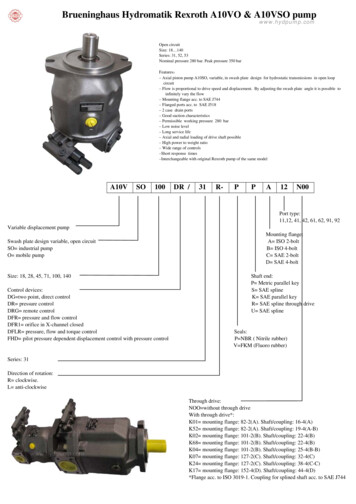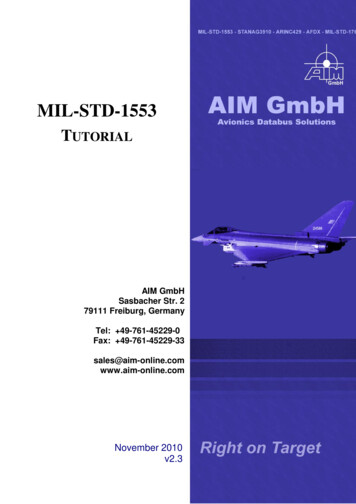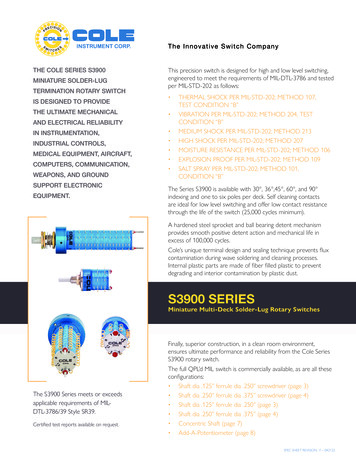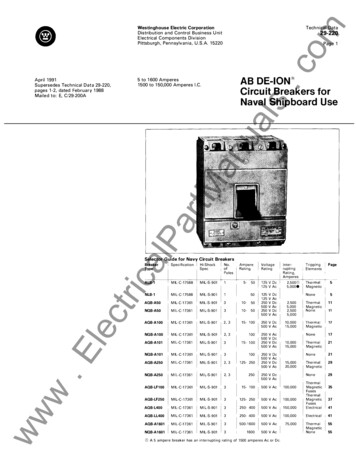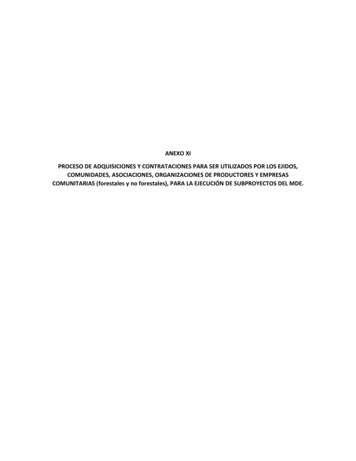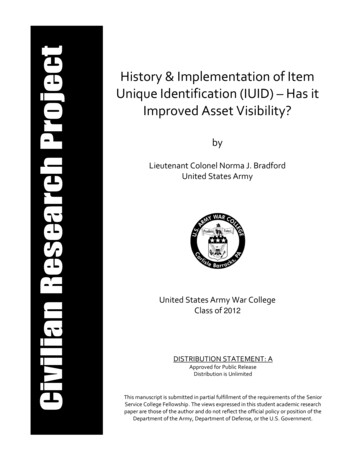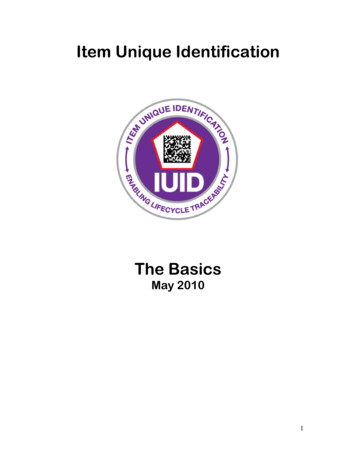
Transcription
Item Unique IdentificationThe BasicsMay 20101
Table of ContentsIntroduction . 3Regulatory Environment . 4Item Unique Identification Program . 4The Policy and Regulations . 5The Policy and Regulations . 6Policy . 6Acquisition Regulation . 7IUID Life Cycle . 8What Items To Unique Identify . 9Item Unique Identification Mark . 112D Data Matrix . 11Constructed Item Unique Identification. 11Construct 2: Serialization Within the Original Part, Lot or Batch Number. 12IUID Equivalents . 13Encoding the UII Data . 13Issuing Agency Codes for Use in Item Unique Identification . 14Reader Technology . 16Accounting and Valuation of Items . 17Data Submission . 18IUID Registry. 18Data Elements in the IUID Registry . 19Summary . 20Appendix A: Referenced Directives for the UID Program . 21Appendix B: Industry References . 222
IntroductionOne of the cornerstones of theThe leading military mission given to the U.S. military forces under theDepartment of Defense (DoD)transformed defense strategy is: Defend the U.S.business transformation process Assure friends and allies;is the implementation of Unique Deter aggression and coercion forward in critical regions; Swiftly defeat aggression in two overlapping major conflicts whileIdentification (UID) across thepreserving for the President the option to pursue a decisiveEnterprise. This includesvictory in one of those conflicts including the possibility of regimechange or occupation; andpersonal property, real property, Conduct a limited number of smaller-scale contingencypersonnel and roles, and willoperations.enable accountability andvaluation of property, and provide the tools to manage historical data, status ofpersonnel and equipment, and inter-organizational relationships. This guideaddresses the personal property component of UID, which includes DoD owneditems, and is referred to as Item Unique Identification (IUID). The guide isdesigned to provide an opportunity for the Department of Defense (DoD)Components, Military Services, and industry to gain insight into the Department’sinitiative on improving asset management through uniquely identifying property,plant and equipment, operating materials and supplies. The guide will examinethe relationship between the legislative and regulatory environment motivatingthis program, the policy, implementation, business rules, marking, and valuationprocess.The definitions below form the basis of the discussion about the DoD ItemUnique Identification (UID) policy.DoD Item Unique Identification means a system ofmarking items delivered to DoD with unique itemidentifiers that have machine-readable data elements todistinguish an item from all other like and unlike items.A Unique Item Identifier (UII) is a set of data elementsmarked on an item that is globally unique andunambiguous.3
Regulatory EnvironmentThe last several years, the General Accounting Office (GAO) has been critical ofthe Department’s accountability and control over property, plant and equipment,and its lack of compliance with financial management reform legislation. This hasincluded the inability to achieve a “clean audit”, and the inability of many of theDepartment’s property systems to properly support the need for asset visibility,engineering analysis and logistics support. As a result, the Department initiateda business transformation process that includes IUID, which will enable theDepartment to value property to achieve a clean audit, and provide the tools fortotal asset visibility across the Defense Enterprise. The result will be improvedfinancial management, engineering and logistics support through the ability tolink and analyze data.Item Unique Identification PolicyThe Item Unique Identification (UID) policy is the foundation for enabling DoD toreach established goals and objectives through enhanced item visibility,improved lifecycle item management and accountability, and enabling cleanfinancial audits.“In every troop deployment this century, DoD has been plagued by amajor difficulty—the inability to see assets as they flow into a theaterand are in storage. This situation has led to direct and significantdegradation in operational readiness. When assets in the pipeline arenot visible, they are difficult to manage. Property is lost, customerssubmit duplicate requisitions, superfluous material chokes thetransportation system, and the cycle continues. Assets at the retaillevel that are not visible and, therefore, not available for redistribution,further compound the degradation of operational readiness.” JointTotal Asset Visibility Strategic Plan, January 1999, Joint Total AssetVisibility Office, DoD.The use of the machine-readable marks required by the IUID policy willsignificantly improve the quality of data, enable speedy and precise automaticdata capture, streamline processes for data accumulation and processing, andensure integration and interoperability across multi-operational boundaries.It will also facilitate item tracking in DoD business systems and provide reliableand accurate data for program management, engineering and accountabilitypurposes.With the ability to distinguish one item from another, IUID ensures data integrityand data quality throughout life, and supports multi-faceted business applications4
and users. This will enable the achievement a globally interoperable networkcentric architecture for the integrated management and valuation of items.Why IUID?1)2)3)4)5)6)AnswerIUIDImproves inventory management and strategic purchasingEnables clean audit/valuationEnables speedy and precise automatic data captureEnables capability-based operational readinessLowers life cycle management costsEnables reliable accountability and visibility5
The Policy and RegulationsPolicyOn July 29, 2003, the "Policy for Unique Identification (UID) of Tangible Items New Equipment, Major Modifications, and Reprocurements of Equipment andSpares," was issued making IUID a mandatory DoD requirement on allsolicitations issued on or after Jan. 1, 2004.Significant UID Policy Memoranda:IUID ImplementationAnnouncementPolicy for Unique Identification (UID) of Tangible Items - NewEquipment, Major Modifications, and Reprocurements ofEquipment and SparesUSD (AT&L) Memo ofJuly 29, 2003Contract Pricing and Cost Accounting – Compliance withDFARS 252.211-7003, “Item Identification and Valuation”USD (AT&L) Memo ofJuly 9, 2004Policy for Unique Identification (UID) of tangible personalproperty legacy items in inventory and operational use includingGovernment Furnished Property (GFP)USD (AT&L) Memo ofDecember 23, 2004Policy update for item Unique Identification of tangible personalproperty including government property in the possession ofcontractorsUSD (AT&L) Memo ofMay 12, 2005The Policy Memorandum of July 9, 2004 provides guidance for DoD contractingpersonnel in pricing and accounting associated with implementing the DFARSclause 252.211-7003.The Policy Memorandum of December 23, 2004 defines step-by-step proceduresfor IUID management, milestones, procedures and processes of legacy items ininventory and operational use as well as government furnished property. The keypoints of the memorandum include: Planning guidelines for IUID implementation Guidance for preparation of Program Plans Establishment of Depot capabilities for management of IUID Identification of IUID International standards IUID Quality Assurance Standards Policy on IUID data for embedded items Policy on Virtual Unique Item Identifiers Rules for data capture of legacy items Information on UID Web Site updatesThe Policy Memorandum of May 12, 2005 provides updated policy andimplementation guidelines, establishes requirements for applying IUID to DoDproperty in the possession of contractors (PIPC) and provides policy for6
furnishing government property in general. The key points of the memoranduminclude: Principles for electronic property management Milestones for PIPC compliance with IUID requirements Direction that all acquisition milestone reviews address IUIDImplementation Revisions to logistics policy to support IUID Development of AIS to support IUID Updated milestone criteria for IUID Program Plans Policy clarification associated with Part Number changesA key aspect of implementing IUID for PIPC is the transition away from thepaper-based DD Form 1662, DoD Property in the Custody of Contractors, to anelectronic PIPC environment using the IUID Registry to report governmentproperty in the contractor’s possession. Additional guidance on transitioningfrom the current reporting process for PIPC is provided fAdditional policy information can be accessed through the IUID website hen did therequirement take effect?AnswerJanuary 1, 2004 for all new DoDsolicitations and orders.Acquisition RegulationThe Federal Acquisition Regulation (FAR) is the body of regulations, which is theprimary source of authority for the government procurement process. TheDefense Federal Acquisition Regulation Supplement (DFARS) is a supplement tothe FAR that includes clauses particular to DoD contract procurement. TheDFARS contains the rules used by DoD and its suppliers to comply with IUIDpolicy when solicitations are issued.The DFARS rule for IUID is DFARS clause 252.211-7003, Item Identification andValuation (June 2005) with updated rules April 2008. It provides policy,definitions, contractor requirements, criteria for marking, reporting criteria, rulesfor embedded assets, data submission and subcontract pass-through criteria.7
The DFARS rule and pertinent clauses are RS Case 2007-007.pdfIUID Life CycleThe IUID enables traceability of the item throughout its life within the DoDinventory and maintenance systems. Figure 1 illustrates the IUID lifecycle andthe business rules at each phase. Business rules illustrated in Figure 2 on thesubsequent page have been developed to determine when an item is to bemarked.Figure: 1 – The Item Unique Identification (IUID) Lifecycle8
What Items to Unique IdentifyAll solicitations, contracts or delivery orders for tangible items delivered to theGovernment will require item unique identification or a DoD recognized uniqueidentification equivalent, if: All delivered items 1 for which the Government's unit acquisitioncost is 5,000 or more Items for which the Government's unit acquisition cost is lessthan 5,000, when identified by the requiring activity as seriallymanaged, mission essential, or controlled inventory Items for which the Government's unit acquisition cost is lessthan 5,000, when the requiring activity determines that permanentidentification is required Regardless of value-o Any DoD serially managed subassembly, component, or partembedded within a delivered item; ando The parent item (as defined in 252.211-7003(a)) that containsthe embedded subassembly, component, or part.Figure 2 contains a decision tree defining the business rules for determining whatitems should be uniquely identified. The DoD requiring activity issuing thesolicitation is responsible for identifying items for IUID when they are under the 5,000 threshold or are embedded items.Figure 2. The Decision Tree to Uniquely Identifying Items1A single hardware article or unit formed by a grouping of subassemblies, components, or constituentparts. [DFARS 252.211-7003(a)]9
Please refer to http://www.acq.osd.mil/dpap/pdi/uid/index.html for additionalguidance.Who is responsible fordetermining what itemsrequire IUID?AnswerThe contracting office issuing the solicitation should reference DFARS 252.211.7003 anddefine and list the items requiring identification and/or valuation.The portion of the clause addressing the decision tree is DFARS 252.211.7003 (c) Unique item identification.(1) The Contractor shall provide DoD unique item identification,or a DoD recognized unique identification equivalent, for-(i) All delivered items for which the Government's unitacquisition cost is 5,000 or more; and(ii) The following items for which the Government's unitacquisition cost is less than 5,000:Contract line, subline, or exhibit lineitem No.Item --- ------------------ ----------------- ---------------------------(iii) Subassemblies, components, and parts embedded withindelivered items as specified in Attachment Number ------.Note Contracting Office Must Fill In Based On Input From The Requiring Activity10
Item Unique Identification Mark2D Data MatrixThe Unique Item Identifier (UII) identifies an item with a set of data that is globallyunique and unambiguous. The symbology used for the mark on an item is a 2dimensional (2D) Data Matrix symbol with Error Correction Code 200. The UII isencoded into a Data Matrix symbol with a software package.Data Matrix symbols have a checkerboard appearance, witheach uniformly spaced square shaped cell corresponding toa data bit. They are constructed of a mosaic of light and darkelements that must all be read before any characters can berecognized. Matrix symbols are encoded with a binary coderequiring an imager to read them. A Data Matrix can storefrom 1 to about 2,000 characters. The symbol is square orrectangular and can range from 0.001 inch per side up to 14inches per side.The Data Matrix can be marked directly on the item surface or by affixing a labelor data plate to the item, as long as it remains permanent through the life and notdamaged or destroyed in use.Some of the benefits of using 2D Data Matrix Technology versus a standardbarcode are as follows: Can contain 100 times the data as the same space in a barcode; Can be read omni-directionally; Can be damaged but still return accurate data; Can be scaled up or down to fit within available marking space.An imager is used to retrieve the UII data elements from the item, which can thenbe assembled into a concatenated UII and transmitted to a database. DataMatrices cannot be read using an ordinary linear barcode laser scanner.The Data Matrix will contain data represented in a uniquely identified codeassigned to an individual item. The code will either contain the necessary dataelements to construct the concatenated UII or will contain a DoD-approved IUIDEquivalent.Constructed Item Unique IdentificationThe set of data elements encoded in the Data Matrix is driven by the methodused to construct the UII. The UII can be one of the following:1) a UII Construct #1, serialization within the enterprise identifier2) a UII Construct #2, serialization within the original part, lot or batchnumber3) a DoD recognized IUID Equivalent.11
An enterprise is the entity responsible for assigning the unique identifier to anasset. The enterprise identifier of the enterprise that assigned the serial numberto the item is the only enterprise identifier in the IUID machine-readable code thatcan use a IUID data qualifier for enterprise identifier.Construct 1: Serialization within the Enterprise IdentifierFor items that are serialized within the enterprise identifier, unique identificationis achieved by a combination of theUII Construct #1issuing agency code (IAC) 2 ,enterprise identifier (EID) 3 and theEIDMFR 0CVA5serial number, which must be uniqueSerial No.SER 786950within the enterprise identifier. Theunique serial number within theenterprise identifier is a combinationUII Construct #1of numbers or letters assigned by theD0CVA5786950enterprise to an item that provides forthe differentiation of that item fromIAC EID Serial No.any other like or unlike item and isnever used again within the enterpriseThis example uses ATA Text Element Identifiersidentifier. The data elements ofenterprise identifier and unique serial number within the enterprise identifierprovide the permanent identification for the life cycle of the item.Construct 2: Serialization Within the Original Part, Lot or BatchNumberFor items that are serialized within the original part, lot or batch number, uniqueidentification is achieved by a combination of the issuing agency code (IAC),enterprise identifier (EID), the original part, lot or batch number, and the serialnumber. The original part number is aUII Construct #2combination of numbers and lettersassigned by the enterprise at assetEID(12V)194532636creation to a class of items with theOrig. Part No. (1P)1234Serial No.(S)786950same form, fit, function, and interface.The lot/batch number is an identifyingnumber assigned by the enterprise to aUII Construct #2designated group of items, usuallyreferred to as either a lot or a batch, allUN1945326361234786950of which were manufactured underidentical conditions. The serial numberDUNS Orig. Serial No.IACwithin the original part, lot or batchPart No.number is a combination of numbers andThis example uses MH10.8.2 Data Identifiers.2The issuing agency code, or IAC, is that assigned by the Registration Authority for ISO/IEC 15459-2,Registration Procedures. The current Registration Authority of ISO/IEC 15459-2 is NEN–NederlandsNormalisatie-instituut. The IAC represents the agency that issued the enterprise identifier. The IAC can bederive from the data qualifier for the enterprise identifier and does not need to be marked on the item.3An enterprise identifier is a code uniquely assigned to an enterprise by a registered issuing agency.12
letters assigned by the enterprise to an item that provides for the differentiation ofthat item from any other like item. The data elements of enterprise identifier,original part, lot or batch number and serial number within the original part, lot orbatch number provide the permanent identification for the life cycle of the item.IUID EquivalentsThe policy adopts, to the maximum extent practical, DoD recognized IUIDequivalents. A commercial identifier can be considered for use as a DoD IUIDequivalent if it meets the following criteria:(1) Must contain an enterprise identifier,IUID Equivalent(2) Must uniquely identify an individualitem within an enterprise identifier, productor part number, and800406141411A0B9C3D6(3) Must have an existing Data Identifier(DI), Application Identifier (AI) listed inANSI MH10.8.2, Data Identifier andIUID EquivalentApplication Identifier Standard.06141411A0B9C3D6IAC EID IndividualThis example uses an EAN.UCC Global IndividualAsset IdentifierThere are currently four commercialunique identifiers meeting these criteriathat are recognized as IUID Equivalents,as follows:1. The EAN.UCC Global IndividualAsset Identifier (GIAI) for serially-managed assets,2. The EAN.UCC Global Returnable Asset Identifier (GRAI) for returnableassets when they are serialized,3. The ISO Vehicle Identification Number (VIN) for vehicles, and4. The Electronic Serial Number (ESN) for cellular telephones only.Encoding the UII DataIn order to be encoded into the Data Matrix, the data elements must be named,as demonstrated in the examples above. Data qualifiers are used to name eachdata element. Specific data qualifiers are used to tell the imaging deviceswhether to derive the unique identification by using Construct #1, Construct #2,an already constructed UII format, or a DoD Recognized IUID equivalent.A data qualifier is a specified character or string of characters that immediatelyprecedes a data element and defines the general category or intended use of thedata that follows. There are three types of data qualifiers being used: DataIdentifiers (DIs) (Format 06), Application Identifiers (AIs) (Format 05), and, withinthe aerospace industry, Text Element Identifiers (TEIs). Table 1 outlines theavailable data qualifiers for the IUID data elements. When deriving the13
concatenated unique item identifier (UII), the data qualifiers are eliminated fromthe final number.Data QualifiersData IdentifiersConstruct #1Construct #218S25S17V, 12V, 3V,18V1P or 1TS9501 or 1021CAG, MFR orSPL,DUN, EUCPNO, LOT or BIISEQUIDApplicationIdentifiersText ElementIdentifiersCAG, MFR orSPL,DUN, EUCSER or UCNUSN or USTDoD Recognized IUIDEquivalentsI22S800280038004Table 1. Data Qualifiers and Their Usage by Constructs/EquivalentsFor additional information on these data qualifiers, please refer IDGuide.pdfIssuing Agency Codes for Use in Item Unique IdentificationOnce the UII data elements are encoded in the Data Matrix, the concatenated UIIcan be constructed and forwarded to the IUID Registry. The concatenated UIIconsists of adding an Issuing Agency Code to the string of UII data elementsencoded in the Data Matrix (the IAC is not physically marked on the item butderived from the EID). The imaging device can be programmed to recognize theIAC from the type of enterprise identifier being used. Table 2 shows the morecommon enterprise identifiers in use and their associated IACs.IssuingAgencyCode0–9LBUNDLDIssuing AgencyEnterpriseIdentifierGS-1EAN.UCCTelcordia Technologies, IncANSI T1.220Dun & BradstreetDUNSAllied Committee 135CAGE/NCAGEU.S. Department of DefenseDoDAACEuropean Health IndustryLHBusiness CommunicationsEHIBCCCouncilTable 2. Data Qualifiers and Their Usage by Constructs/Equivalents14
Table 3 summarizes the business rules for creating each of the UII Constructs.Table 3. Unique Item Identifier (UII) Construct Business RuleData elements for item unique identification (enterprise identifier, serial numberand, for Construct 2 only, original part, lot or batch number) will be placed onqualifying items in accordance with the standard practice of the current version ofMIL-STD-130 IL-STD-130N20080111.pdf) Identification Marking of U.S. Military Property. The compliantmark is the 2D Data Matrix, and is required for all UIIs, including IUIDEquivalents. For a greater understanding of the marking methods, please referto most recent version of the DoD Guide to Uniquely Identifying DoDUIDGuide.pdf), as well asTips on Constructing the ps%20on%20Constructing%20the%20UII.pdf).Who decides what UIIconstruct to use?AnswerThe enterprise assigning serializationto the item is responsible for decidingwhich construct to use.15
A delivered item may include embedded items, such as subassemblies,components and parts, which have been specified for IUID marking. The primecontractor will pass down appropriate specifications, including the IUID markingrequirements, to the tiered vendors for subcontracted subassemblies,components and parts. Spares may be purchased directly from the vendors orthrough the prime contractor. IUID qualifying spare items have to be markedappropriately with the IUID data elements. So, when the prime delivers the enditem—that is one UII. The spares are delivered with their own UIIs. TheGovernment will require the prime to provide the data on all UIIs including IUIDqualifying embedded items in the delivered item.DoD program offices and industry partners continue to share best practices onIUID part marking that minimizes financial and physical impact. The UID PolicyOffice has ongoing working groups that meet with DoD stakeholders in order toshare approaches. For more information, please go ader TechnologyAs stated earlier, the data matrix symbol requires a 2D imager; they cannot beread using an ordinary linear barcode laser scanner. Automatic IdentificationTechnology (AIT) is the basic building block in the Defense Department's effortsto provide timely asset visibility. AIT gives the Department the capability toelectronically capture information about items as they move through theoperational environment, providing both reliable and accurate data capture andtransmission throughout the item lifecycle.The AIT reader will accurately and reliably machine read the data elements andoutput a UII. The data will be transmitted to a DoD automated informationsystem. The data can then be used as a primary or alternate key across DoDdatabases.A number of resources are available to provide more information on AITTechnology:1) The Defense Acquisition University Special Interest Area provides AITsolution provider information, in addition to a host of other IUID-relatedinformation. It is accessible at the secure link https://acc.dau.mil/uid2) Association for Automatic Identification and Mobility (AIM) is a global tradeassociation comprising providers of components, networks, systems, andservices that manage the collection and integration of data withinformation management systems (www.aimglobal.org)3) Product Manager, Joint-Automatic Identification Technology (PM J-AIT) isthe Army’s Center of Excellence for the automatic reading technologiesthat are an integral part of the implementation of the UID. It supports its16
DoD customers with AIT reading equipment, devices, supplies, andtechnical assistance (http://www.ait.army.mil).Accounting and Valuation of ItemsThe first part of this guide focused on the IUID program, implementation and itemmarking. The final section of this guide will focus on the accounting andvaluation process. The purposes of the DFARS clause is to both uniquelyidentify and value items to provide better asset accountability and valuationthrough the IUID life cycle mentioned in Figure 1 on page 8. A number of DoDDirectives provide internal guidance on DoD Program responsibilities related toproperly accounting and valuating items. IUID costs are allowable. The DoDDirectives can be found in Appendix A.Accountability of items begins when equipment, reparables, materials andconsumables are acquired through purchase, lease, or other means.1. DoD Instruction 5000.64 requires that accountability records beestablished for all property (i.e., property, plant and equipment)purchased, having a unit acquisition cost of 5,000 or more, and itemsthat are classified or sensitive, or items located at third parties, regardlessof acquisition cost.2. For material covered under the DoD 4140.1-R publication, accountabilityrecords are established for all material received, regardless of cost.All property delivered to the Government must be delivered on a contract lineitem number (CLIN), sub-line item number (SLIN) or exhibit line item number(ELIN). The acquisition cost of each item entering the Government propertyinventory is captured on CLIN, SLIN, or ELIN.Both the unique identification and value of items delivered under the contractneed to be reflected in the DoD property accountability and managementinformation systems. The valuation of property is addressed in DoD Instruction5000.64 and states that unit acquisition cost should be the basis for valuation ofproperty. The contract type determines the proper method of calculating unitacquisition cost.1) For fixed-price type CLIN, SLIN, or ELIN items, it is the unit price identifiedin the contract at the time of delivery2) For cost-type or undefinitized CLIN, SLIN, or ELIN items, it is thecontractor's estimated fully burdened unit cost to the Government at thetime of delivery3) For items delivered under a time-and-materials contract, it is thecontractor's estimated fully burdened unit cost to the Government at thetime of delivery.The Government's unit acquisition cost of subassemblies, components, and partsembedded in delivered items need not be separately identified.17
For a greater understanding of the valuation methods, please refer to the DoDGuide to Uniquely Identifying DoDUIDGuide.pdf).Data SubmissionWide Area Work Flow (WAWF) -Receipt and Acceptance is the standardizeddata ca
DFARS contains the rules used by DoD and its suppliers to comply with IUID policy when solicitations are issued. The DFARS rule for IUID is DFARS clause 252.211-7003, Item Identification and Valuation (June 2005) with updated rules April 2008. It provides policy, definitions, contractor requirements, criteria for marking, reporting criteria, rules
